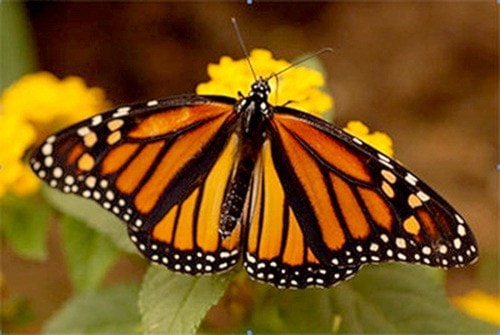OTTAWA, Dec. 5, 2016 /CNW/ - From Coho Salmon to Caribou to the much-cherished Monarch butterfly, migration is a key component of Canadian biodiversity. Migratory species, migration and movement all figured prominently at the semi-annual Committee on the Status of Endangered Wildlife in Canada (COSEWIC) deliberations on species at risk, held Nov. 27 - Dec. 2.
Young Coho Salmon from the Interior Fraser River basin leave the watershed and live much of their adult lives at sea before migrating back to their native rivers to lay eggs. The Committee considered threats in both fresh and salt water, and the wildlife species’ status was assessed as having improved from Endangered to Threatened. Despite ongoing active management and some improvements, the situation faced by Interior Fraser River Coho Salmon is still perilous.
Another iconic migratory species considered by COSEWIC was Caribou. Several populations migrate hundreds of kilometres en masse between their calving and wintering grounds every year. Caribou have experienced alarming declines. Both science and Aboriginal Traditional Knowledge indicate unprecedented declines in several herds with some human activities on the landscape being novel, potentially disrupting natural cycles.
According to Justina Ray, co-chair of the Terrestrial Mammals Subcommittee, “Caribou are, sadly, very sensitive to human disturbances, and we are disturbing Caribou more and more. These stressors seem to be interacting in complicated ways with rapid warming in the North. Many of the great northern Caribou herds have now fallen to all-time lows, and there is cause for concern that they will not rebound in the same way they have before.”
COSEWIC considered the status of two such populations for the first time. Both were found to be in trouble: The Caribou Barren-ground population was assessed as Threatened, while the much rarer Torngat Mountain population in far northeastern Canada was assessed at even higher risk - Endangered.
A third migratory species considered by COSEWIC was the Monarch butterfly. These insects fly over 4,000 kilometres south to Mexico in the fall to overwinter. They breed on their return trip, and their great-grandchildren arrive back in Canada in spring. However, the remarkably tiny wintering grounds where Monarchs congregate continue to be chipped away by habitat loss. Monarch butterfly migration is now recognized as a “threatened process” by the International Union for the Conservation of Nature (IUCN). Indeed, it is the only natural process with this unfortunate distinction. COSEWIC assessed the species as Endangered.
Jennifer Heron, co-chair of the Arthropods Subcommittee, summed it up: “We need to continue to support the conservation of milkweed caterpillar habitat both here in Canada and along the Monarch’s migratory journey, and we need to support continued conservation of critical overwintering areas. Otherwise, Monarch migration may disappear, and Canada may lose this iconic species.”
The Pink-footed Shearwater finds itself in a comparable situation. Breeding on only three small islands off the coast of Chile, many of these birds travel thousands of kilometres north to feed along the coast of British Columbia during our summer months. The species’ southern home is under multiple threats from humans and exotic predators, and shearwaters are killed as fishing by-catch throughout its range. This rare bird was re-assessed as Endangered.
Human interference also causes problems for animal movements at smaller, local scales. Dams that stop Westslope Cutthroat Trout from moving between spawning and feeding grounds have contributed to their shrinking distribution in Alberta. This fish’s Saskatchewan – Nelson Rivers populations were re-assessed as Threatened. Slow-moving Blanding’s Turtles, which can live for 80 years, travel up to three kilometres from nesting beaches and other summer habitats to fewer small freshwater pools where they overwinter, year after year. Vehicles increasingly threaten this rare turtle wherever roads cross the turtles’ seasonal routes, and this species was assessed as Endangered in both Nova Scotia and in central Canada.
In contrast to most of the species assessed by COSEWIC, the widely distributed Blue Shark was assessed as Not At Risk in Canada, in part due to ongoing successful management. New satellite tracking data for this renowned long-distance migrant confirmed long-range movements and seasonal migrations between inshore and deeper offshore habitats.
But of the species assessed, Blue Shark was the exception. Many migratory species decline in step with human barriers and habitat changes.
The Chair of COSEWIC, Eric Taylor, stated the bottom line: “Disruptions to migratory behavior are associated with the threat of extinction for species all over the world. We will need to continue to change how we use our landscape so that we and wildlife can thrive together. COSEWIC’s work assessing Canadian wildlife helps us do that.”
COSEWIC assesses the status of wild species, subspecies, varieties, or other important units of biological diversity, considered to be at risk in Canada. To do so, COSEWIC uses scientific, Aboriginal traditional and community knowledge provided by experts from governments, academia and other organizations. Summaries of assessments are currently available to the public on the COSEWIC website (www.cosewic.gc.ca) and will be submitted to the Federal Minister of the Environment and Climate Change in fall 2017 for listing consideration under the Species at Risk Act (SARA). At this time, the status reports and status appraisal summaries will be publicly available on the Species at Risk Public Registry (www.sararegistry.gc.ca). COSEWIC’s next scheduled wildlife species assessment meeting will be held in April 2017.
